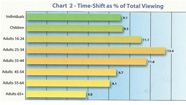UK starts debate on measuring online TV audiences

The UK TV measurement body BARB (Broadcasters’ Audience Research Board) has called for new standards to coordinate different sources of information about TV viewing in the increasingly fragmented world of ‘TV Everywhere’. BARB is also considering revising the definitions of linear and on-demand viewing to reflect the fast-growing consumption of “near live,” catch-up content. These moves came last week at an industry conference where BARB launched its new Measurement Sciences Forum to encourage greater involvement from broadcasters, TV operators, content owners, and Consumer Electronics (CE) vendors in creating a ‘full view of the TV universe’ in the connected TV age.
In launching the Measurement Sciences Forum, BARB Chief Executive Bjarne Thelin argued there was a risk of the industry “ending up with separate collections of incompatible data sets that are just floating around in empty space, occasionally bumping into each other.”
Although BARB is a UK body, the business of TV audience measurement is increasingly international as content is no longer confined to national borders, and there is increasing competition among such agencies. Nielsen, which measures US ratings, now operates globally, producing statistics in other countries including the UK with the same objective: to provide information of use both as a currency for evaluating programs for advertising value; and to help broadcasters with content strategies. In fact, Nielsen is ahead of BARB in its measurement of online and mobile TV viewing, having established representative panels of Internet users to provide metrics on browsing and streaming of TV content. This census approach emulates the traditional audience panel based measurement used by BARB, Nielsen and other ratings agencies to track popular linear channels. The key to success lies in having a sample large enough to serve as a basis for statistically significant extrapolation to the whole population.
For mobile device consumption, though, this approach would not really work given that users tend to watch short clips that could not readily be measured by a panel approach. Here, the task is the opposite, to filter out meaningful information about specific content from a large amount of information taken from some form of meter installed in the device. This is what Nielsen does already to measure mobile TV consumption.
Nielsen claims it can now compile the kind of total audience metric combining consumption figures for given content across TVs, Internet connected devices and mobiles. Its online panel tracks 200,000 Internet users in the US and 500,000 worldwide.
However, BARB believes more research is needed before meaningful information about online and mobile TV consumption can be obtained. Indeed, at the BARB conference last week, it emerged that broadcasters and analysts alike are still unsure whether they have sorted out the best way to distinguish between online and on-demand viewing. At present the UK uses a typical approach where all content consumed immediately is classified as linear, while all viewing afterwards via catch-up services is considered on-demand. However, all viewing of content within seven days of its scheduled broadcast counts toward total audience figures used, for example, by advertisers.
With this model, even if a program is viewed just 15 seconds after the scheduled time via a PVR (Personal Video Recorder) that is recording the content at the same time as playing it out, it is still classed as time-shifted. This could also be done via a ‘Start Over’ service of the kind offered by Time Warner in the US, allowing the consumer to jump straight to the beginning of a program without needing an in-home PVR, since the content is served from the network.
At the BARB meeting, a consensus emerged that the current measurement system treating viewing as either linear or on-demand with no category in between should change. There was less agreement over what this change should be, with one suggestion that viewing starting while the scheduled broadcast is still going on should be reported as a separate “Start Over” category. The most popular idea, though, was that there should be three categories. Linear viewing would be defined as being either at the scheduled time or shortly afterwards. Catch-up viewing would include from that point up through seven days ahead, and on-demand viewing would be defined as consumption of timeless content or was first broadcast more than a week prior.
The professional video industry's #1 source for news, trends and product and tech information. Sign up below.
The debate over how to define and quantify consumption of online and mobile content is even more ragged, with numerous competing suggestions over how to assess level of engagement. Services that allow viewing to begin on one device such as a TV and be resumed on another, which could be a tablet or smart phone, adds a further layer of complexity.
It seems that there are two camps emerging, with BARB agonizing over how to measure total content consumption, while Nielsen is getting on and doing it, aware that the measurements will probably need to be refined in light of experience. Ideally, both approaches should be combined, with trial-and -error interacting with industry-wide consultation.
